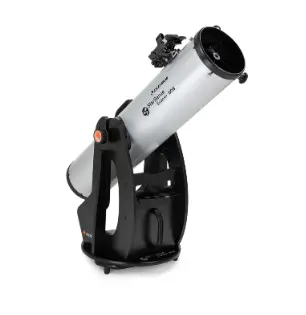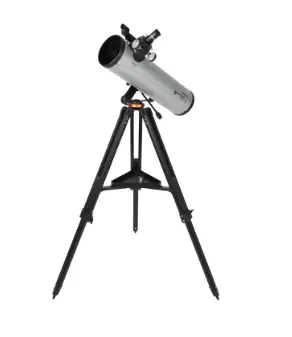If you’re searching for a new telescope, you’ll soon come across two particular telescope designs: Dobsonian’s and Newtonian’s.
But what are they exactly? How do they differ?
How do you determine which is the better fit for your needs?
Well today, I’m going to break down the key features and differences between Dobsonian’s and Newtonians to help guide your buying decision.
What Is A Dobsonian Telescope?
A Dobsonian telescope is a type of Newtonian reflector telescope specifically mounted on a simple alt-azimuth mount.
Named after amateur astronomer John Dobson who pioneered the design, the key components include:
- A parabolic primary mirror as the main light-collecting objective lens.
- A basic mount (alt-azimuth) that allows up/down and side-to-side motion for aiming the telescope tube.
- Large aperture sizes typically ranging from 6 inches up to about 12 inches for typical models.
Dobsonian mounts are designed to be affordable, portable, and provide a stable viewing platform.
The simplicity of the mount mechanics keeps costs low compared to other telescope types.
Dobsonian’s also minimize vibration to deliver clear views, making them popular beginner instruments.

What Is A Newtonian Telescope?
A Newtonian telescope is a type of reflecting telescope invented by Sir Isaac Newton, using a parabolic primary mirror and a flat secondary mirror to reflect light and form an image.
Newtonian telescopes are also reflectors, using a parabolic primary mirror to gather light.
However, the optical tube assembly of a Newtonian can accommodate many different mount designs.
Common options include:
- Equatorial mounts that allow tracking of celestial objects as the Earth rotates.
- Computerized GoTo mounts for automated object targeting.
- Fork mounts like those used in Schmidt-Cassegrain telescopes.
- Static mounts for terrestrial viewing.
This mount versatility provides Newtonians with a wide range of capabilities to suit beginners up through professional use.
Aperture sizes also vary widely, from portable 2-inch models to massive 36-inch+ observatory scopes.

What Are The Differences Between A Dobsonian and Newtonian Telescope
Here are some notable ways Dobsonians and Newtonians differ:
- Dobsonians utilize simple alt-azimuth mounts while Newtonians often use more complex equatorial or computerized mounts.
- Dobsonians are typically limited to about 16 inches aperture; Newtonians can have much larger apertures.
- Dobsonians are designed for easy visual use from almost anywhere; Newtonians excel at astrophotography and research from permanent installations.
- For a given aperture size, Dobsonians are more affordable while Newtonians are more expensive but offer enhanced features.
- Dobsonians are highly portable. Larger Newtonians may require permanent mount structures.
Is A Dobsonian or Newtonian Better?
For Beginners
For starting astronomers who want an easy-to-use, portable telescope capable of great views on a budget, a Dobsonian is likely the better choice. Their simple setup and operation combined with low cost makes Dobsonians ideal beginner instruments.
For More Experienced Astronomers
More advanced astronomers who prioritize astrophotography or want room to grow into more sophisticated capabilities may want to start with an entry-level Newtonian.
Keep in mind the mount and accessories add cost, requiring a larger upfront investment.
Finally
As you consider your telescope design, think about your goals, portability needs, and budget.
Dobsonians and Newtonians each have strengths that make them well-suited for certain interests and constraints.
Figuring out which design aligns best with your stargazing objectives will lead you to the ideal beginner telescope.
FAQs
What Is An Alt-Azimuth Mount?
An alt-azimuth mount is a telescope mounting system that allows movement along two perpendicular axes: altitude (up and down, vertical) and azimuth (side to side, horizontal). It’s simpler and typically more intuitive than equatorial mounts, often used for terrestrial observing and in many Dobsonian telescopes.
Related Guides:
- Dobsonian vs Cassegrain [Difference Between the Telescopes]
- Dobsonian vs Reflector [Difference Between the Telescopes]
- Newtonian vs Cassegrain [What Is The Difference?]

Hey, my name is Jeremy. I’m a passionate and seasoned astronomer who loves nothing more than observing the night sky. I also love researching, learning, and writing all things Space and the Universe. I created Astronomy Scope to share my knowledge, experience, suggestions, and recommendations of what I have learned along the way while helping anyone to get into and maximize their enjoyment of the hobby.

